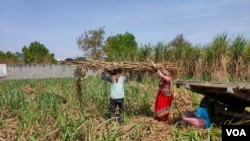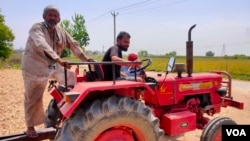After spending a morning loading his freshly harvested sugar cane crop onto a cart under a blazing sun, Krishan Pal feels a little dejected. He says profits from his one-hectare farm in India’s northern Uttar Pradesh state have dwindled in recent years due to rising costs of essentials like fertilizer and pesticide.
“This government is not looking at the expenses we incur," he told VOA. "It is not helping farmers.”
Despite his frustrations, Pal will back Prime Minister Narendra Modi’s ruling Hindu nationalist Bharatiya Janata Party, or BJP, which is seeking a third term in upcoming general elections.
“I think this is a nation of Hindus. Hindus should stay in power,” he said.
Politically pivotal region
For the estimated 200 million residents of Uttar Pradesh — a state more populous than Brazil and lesser developed than other Indian states — issues such as falling incomes, joblessness and rising prices are talking points among urban and rural communities as April 19 elections approach.
In a market in Muradnagar town, a group of shopkeepers discuss their businesses while awaiting customers. Mohammed Ashraf says his business of supplying fresh milk to customers has shrunk due to competition from young unemployed people entering the same line of work.
“There are no jobs in companies,” Ashraf said. “In 10 years, what has the government given? Employment avenues have [been] reduced. People want jobs, businesses, not just roads. What will young people do?”
But for many voters, such concerns remain on the back burner. Across the towns and villages of Uttar Pradesh, the overwhelming sentiment is staunch support for Modi’s ruling BJP — much as it was in the 2014 and 2019 elections that cemented its political dominance.
And because of its sheer numbers — the state determines 80 of 543 elected lawmakers in India's lower house of parliament — whichever party holds sway over Uttar Pradesh is most like to secure the parliamentary majority needed to govern.
Favorable polls
Most recent surveys project a landslide victory for BJP in the six weeks of voting that begin April 19, with the party taking 70 of 80 seats in Uttar Pradesh alone.
Surveys also indicate an opposition alliance called INDIA is expected to fare poorly in the state, with the once regionally dominant Samajwadi Party, which ruled Uttar Pradesh between 2012 and 2017, picking up less than 10 seats.
Regional support for BJP, say analysts, is fueled by the party’s Hindutva ideology, which puts Hindu national identity and improved governance at heart of its movement. Since 2017, Uttar Pradesh has been headed by prominent BJP official Yogi Adityanath, a Hindu priest turned politician.
Despite the lack of jobs and widespread regional poverty, some farmers like Kapil Tyagi say they’re satisfied with local development since Modi’s rise to power.
“The government has done good work,” he said. “A water tank has been installed. The electricity supply is regular, and we will be getting a road soon.”
As Tyagi spoke, a group of people gathered around, nodding silently in agreement.
Some 40 kilometers away in bustling Ghaziabad, the largest city in western Uttar Pradesh, entrepreneur Manan Anand says he found it easy to secure a bank loan for his venture.
In a state that once had a high crime rate, he says, he’s happy to see safety has improved.
“Modi’s government is doing fairly good as compared to earlier governments,” said Anand. “Girls and women can go out easily in the evening, that was not the case earlier.”
Although Anand says more needs to be done to expedite development, he’s optimistic the Modi government is on the right track.
‘Modi guarantees’
Modi’s appeal is built on a variety of factors, according to political analyst and author Neerja Chowdhury.
“He is seen as the king of Hindu hearts,” she told VOA. “He has flagged nationalism and national pride in a big way — BJP has given social welfare schemes that have given money in the hands of many people, what he calls ‘Modi guarantees.’”
In January, Modi inaugurated a grand temple in Ayodhya dedicated to the Hindu deity Lord Ram that stands on the site of a demolished 16th-century mosque, fulfilling a longstanding BJP pledge to rebuild the Uttar Pradesh holy site. Symbolizing the country’s surging Hindu cultural nationalism, it has since drawn pilgrims by the tens of thousands.
“Indians are by nature religious, and Modi and the BJP have brought this to the fore. The opening of the temple has been packaged politically as if Modi played a pivotal role in its construction. He is perceived as the man who delivers,” said political analyst Rasheed Kidwai.
“Even if people face hardship such as lack of jobs, they feel their national roots, their faith, their culture is getting primacy.”
The BJP is also credited with stitching up alliances with small parties to widen its support base throughout the state.
Launching his election campaign from the Uttar Pradesh city of Meerut on March 31, Modi expressed confidence about his party’s reelection.
“Our government has started work for our next term. We are preparing the roadmap for the next five years and talking about the big decisions we will take in the next 100 days,” he told a huge crowd. Modi also spoke about India’s growing stature in the global community and said he aimed to make the country the world’s third largest economy.
On that same day, top leaders of the opposition INDIA alliance gathered in Delhi to accuse Modi and his ruling BJP of undermining democracy by intimidating and arresting political rivals, charges Modi denies.
Officials with the Samajwadi Party, the main opponent to BJP and part of the broader opposition alliance, have also said that protecting democracy and the right to social justice are critical to national development.
Criticism aside, analyst Chowdhury says Modi appeals to a young, aspiring nation.
“He is talking about India 10 years down the line, 25 years down the line, 50 years down the line, selling people dreams which the opposition is not able to match.”
A good showing in Uttar Pradesh will be pivotal to Modi’s ambitions of surpassing his party’s present tally of 303 seats in parliament. India’s elections will be held in seven phases over six weeks with votes being counted on June 4.















